Resolve conflicts
Overview
If you make changes to the same project in different branches, conflicts may occur when you merge the branches.
NDGit provides a feature to help you resolve conflicts in project files.
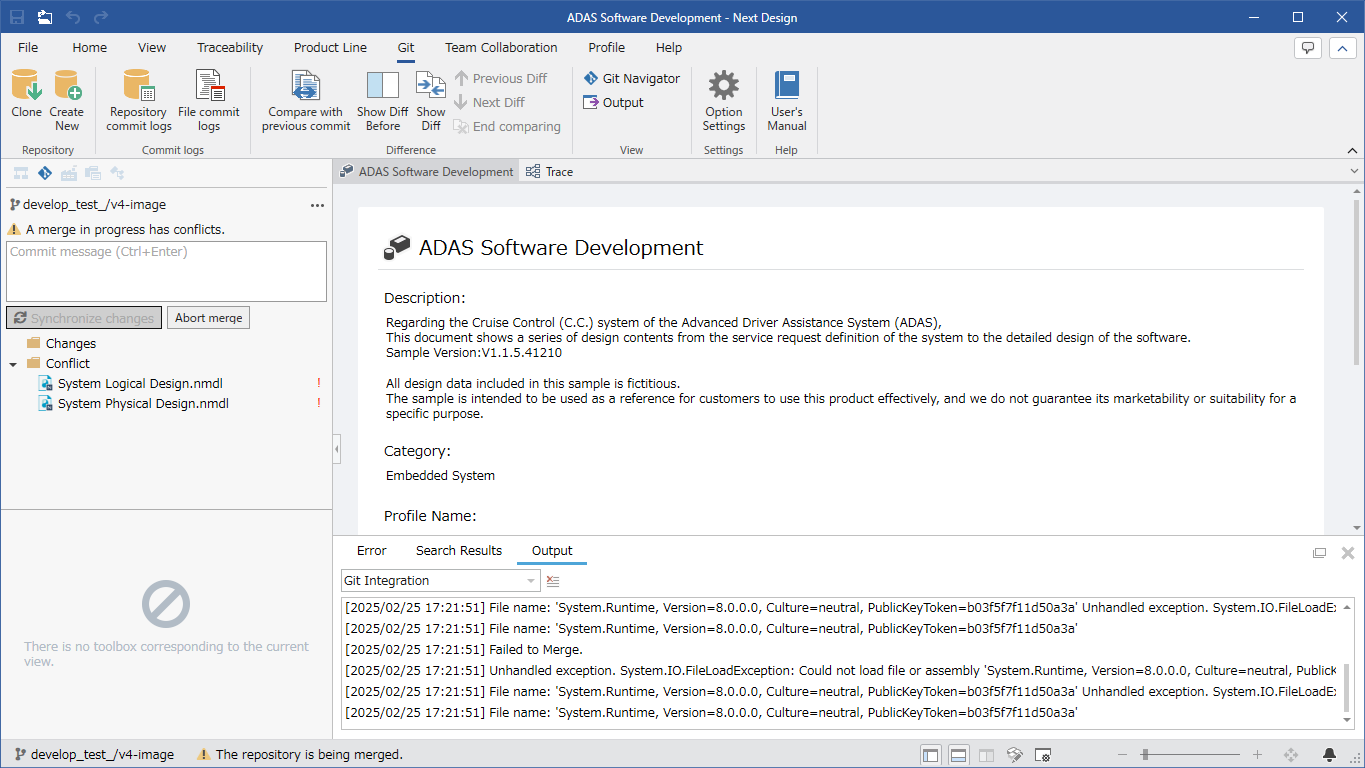
Model conflicts
Resolve conflicts individually
To resolve conflicts by selecting the changes to apply for each conflict individually, follow these steps:
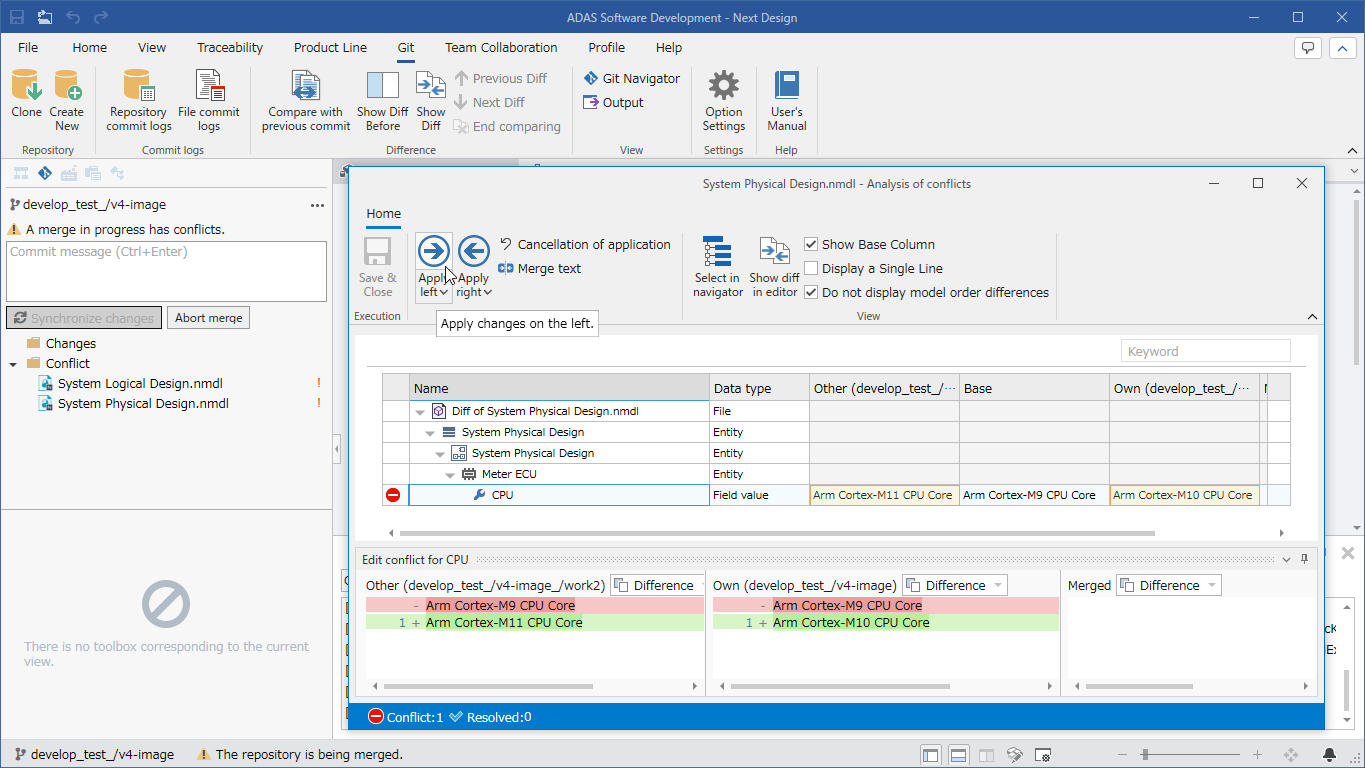
Resolving conflicts individually is available in the Enterprise Edition.
In the Professional Edition, resolve the conflicts by Resolve all at once for each model file described later.
- Hover the mouse over the file for which you want to resolve the conflict.
- Click the [Analyze Conflicts] button to display the [Analyze Conflicts] window.
- Hover the mouse over the ⛔ icon in the window to display the conflict message. (Click here for message details)
- Select the conflicted part and select the change you want to take priority by doing one of the following:
- Click the [Apply Left] button to apply the changes from the merged branch.
- Click the [Apply Right] button to apply the changes from the original branch.
- Once all conflicts have been resolved, click the [Save and Close] button to commit the changes.
-
You can cancel the applied changes by clicking the [Undo Apply] button.
-
If the field value is a string, you can apply the text merged changes of the other side and your side as the changed content by clicking the [Merge Text] button.
-
Click the [Select in Navigator] button to check the changes of the model selected in the [Analyze Conflicts] window in the Next Design editor.
Resolve all at once for each model file
To resolve conflicts by selecting all the changes to apply for each model file at once, follow the steps below.
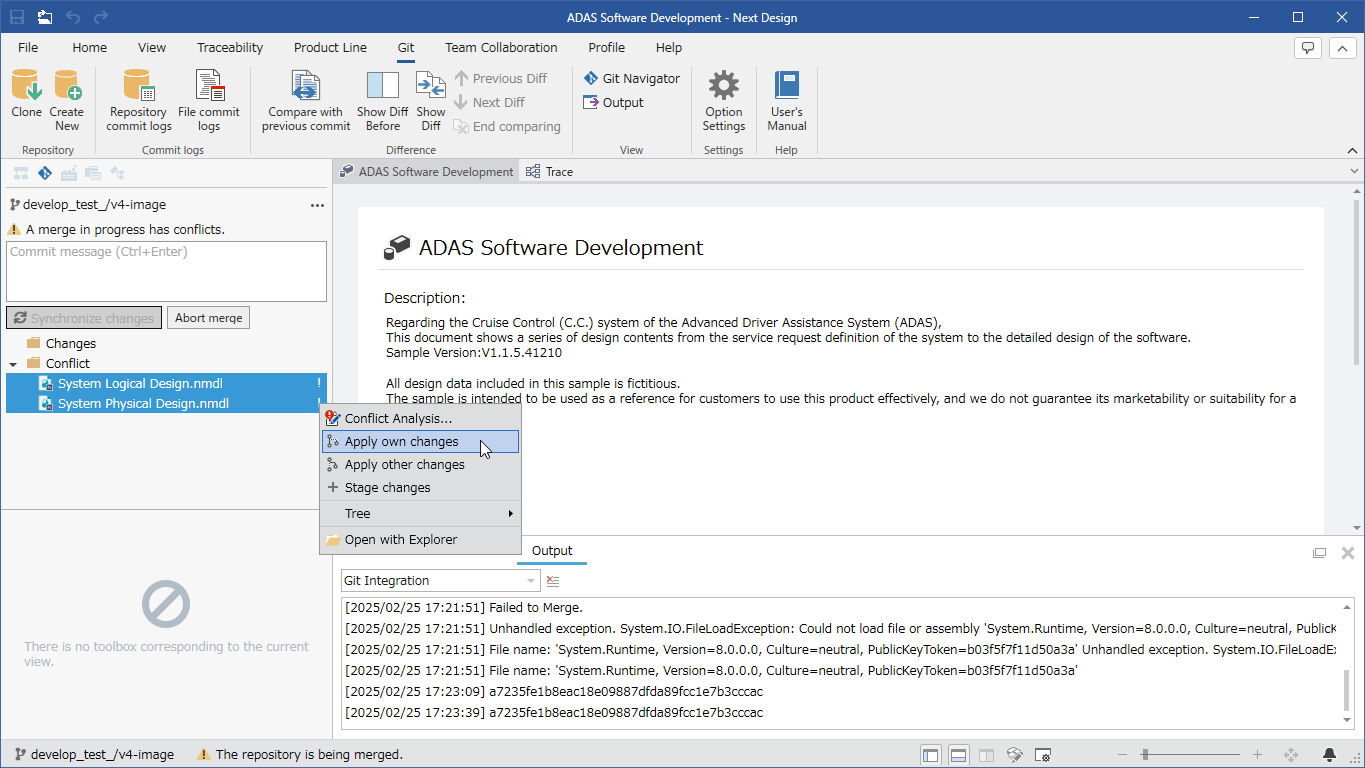
- Select the file for which you want to resolve the conflict and open the context menu.
- Select the changes you want to prioritize by doing one of the following:
- To apply the changes from the merged branch, click the Apply Other's Changes button.
- To apply the changes from the origin branch, click the Apply My Changes button.
Profile conflicts
For profile conflicts, you can resolve the conflict by choosing either the other's changes or your changes for the entire profile.
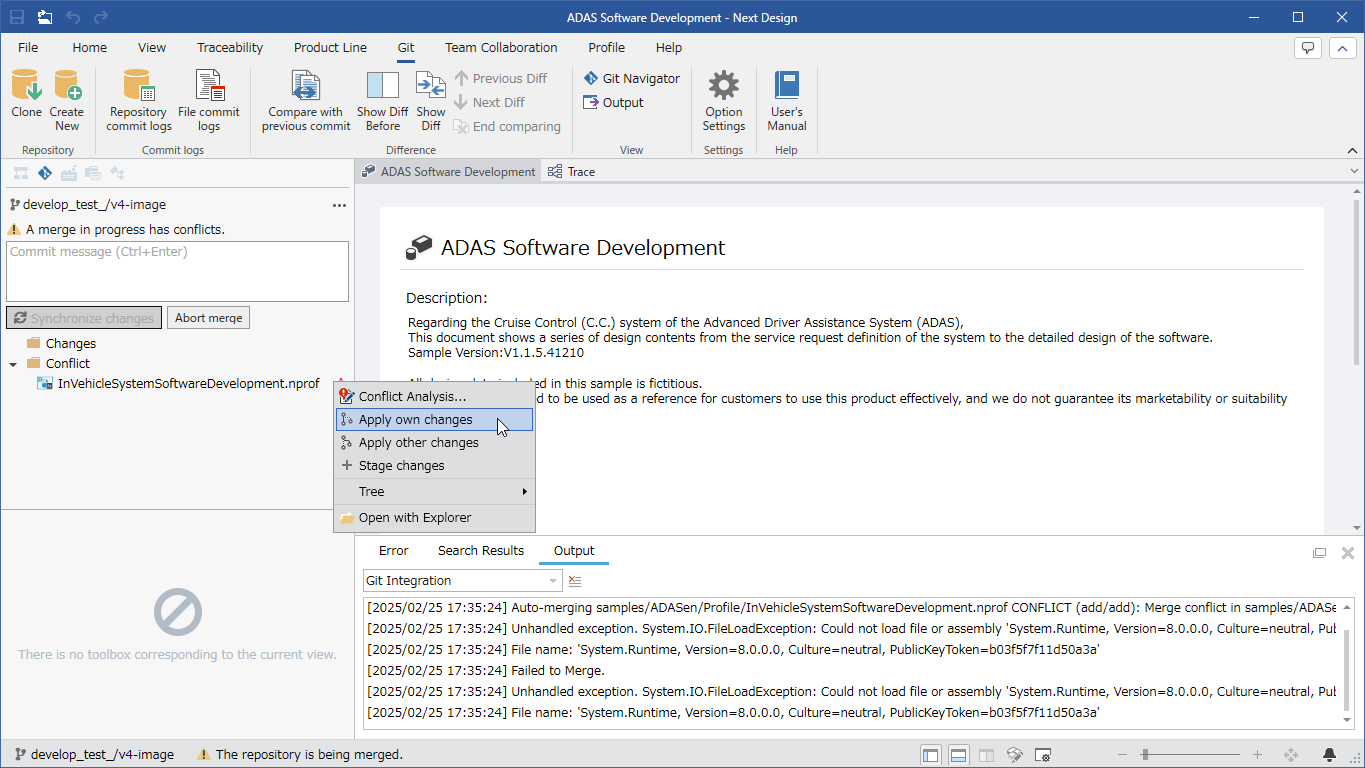
- Select a profile and open the context menu.
- Select the changes you want to take priority by doing one of the following:
- To apply the changes from the merged branch, click the Apply Other's Changes button.
- To apply the changes from the origin branch, click the Apply My Changes button.
List of conflict patterns
This shows all conflicts that can occur when merging branches. This also shows examples of operations that cause these conflicts and how to resolve them.
| No. | Category | Conflict message |
|---|---|---|
| 1 | Model common | The attribute [attribute name] of the element to be deleted is being changed. |
| 2 | Model common | The attribute [attribute name] has been cross-edited. |
| 3 | Model common | The ownership relationship is circular. |
| 4 | Model common | There are multiple ownership relationships that own model name. |
| 5 | Model (product line) | Multiple conditional models are set. |
| 6 | Model (sequence diagram) | The sequence diagram has been cross-edited. |
| 7 | Profile common | The profile has been cross-edited. |
| 8 | Model file | The conflict in this file cannot be resolved. Check the manual for the resolution method, and execute the merge again after making sure there are no inconsistencies. The following are possible reasons why the conflict cannot be resolved. - A different model is split using a file with the same name included before the change - A file with the same name included before the change is renamed - Files with the same name in different folders are moved to the same folder and merged |
| 9 | Model file | The changes to this file could not be displayed because the conditions for comparison were not met. The following may be the case. - A different model is split using a file with the same name included before the change. - The schema version of the file has been changed. - The file path or file name has been changed. |
Solution
- The attribute [
attribute name] of the element to be deleted has been changed.
attribute name] of the element to be deleted has been changed.Condition
When one commit deletes a model and the other commit updates a field of that model, a conflict occurs.

How to fix
Select the model deletion or model field change that you want to apply.
2.1. Attribute [attribute name] is being edited.
attribute name] is being edited.Condition
When one commit updates a model field and the other commit updates the same field to a different value, a conflict occurs.

How to fix
Select the model field change that you want to apply.
2.2. The attribute [UnitPath] has been mutually edited.
UnitPath] has been mutually edited.Condition
If you move the same model file to a different folder in a different branch, a conflict will occur.

How to deal with this
Select the UnitPath of the model file you want to apply.
In addition, in addition to selecting the UnitPath, the actual model file also has a conflict, so apply that as well.
The model file that was not applied must be manually deleted.
- The ownership relationship is circular.
Condition
If you change the parent of a model in one commit, and then change the parent in another commit so that the parent-child relationship is reversed, a conflict occurs.

How to fix
You must avoid circular ownership of models. Specify the direction of application so that there are no circular ownerships.
- There are multiple ownerships that own
model name.
model name.Condition
If you add a model by importing a model file in one commit, and then import the same model file in the other commit, a conflict occurs.
Models with the same ID are added by the import, but the ownership with the parent is different, so a conflict occurs.

How to fix this
A model must have only one parent element.
Specify so that only one owned relationship remains that you want to apply.
- Multiple conditional models are set.
Conditions
If you assign a feature to a model (= set a feature conditional expression) in one commit, and assign a feature to the same model in the other commit, a conflict occurs.

How to fix this
Only one conditional model can be set.
Specify so that only one conditional model remains that you want to apply.
- Sequence diagrams are being mutually edited.
Condition
A conflict occurs when you update a sequence diagram in one commit and update the same sequence diagram in another commit.
For sequence diagrams, a conflict occurs even if you update different elements in the sequence diagram.

How to fix
Details of the differences can be viewed from the ribbon's [View] > [Show Differences in Editor].
For sequence diagrams, you must select one of the changes for the entire sequence diagram.
Select the side you want to apply to the interaction model.
- Profiles are cross-edited.
Condition
A conflict occurs when you update profile information in one commit and update that information in the other commit.

How to fix
Select the file in the profile that you want to use the changes for.
Changes in the unselected file will not be merged regardless of whether there is a conflict or not.
- The conflict in this file cannot be resolved.
Condition 1: Different models are split with the same name file included before the change
If you select different models and give them the same model file name by splitting the model file, a conflict will occur.

How to fix
Conflicts cannot be resolved in Git Navigator.
Review the model file split so that different model files do not end up with model files with the same path and name.
Condition 2: Renaming with a file of the same name included before the change
If you rename different model files to the same model file name, a conflict will occur.
For example, this conflict will occur if you perform the following operations.
- Update the model file in one commit
- Move the model file to a different folder in the other commit
- Rename the moved model file to the same name in the other commit

How to deal with this
Conflicts cannot be resolved in Git Navigator.
Review the model file split so that different model files do not end up with model files with the same path and name.
Condition 3: Files with the same name under different folders are moved to the same folder and merged
If you move a model file in one commit and move a model file with the same name to the same folder in the other commit, a conflict will occur.
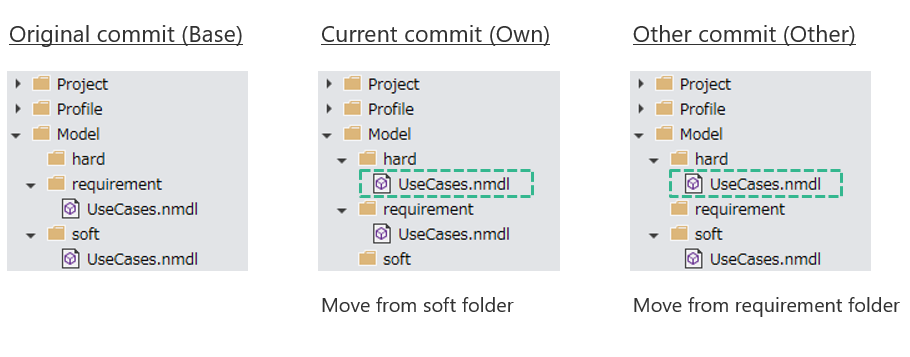
How to fix this
Conflicts cannot be resolved in Git Navigator.
Review the model file splitting so that different model files do not have the same path and name.
- The changes to this file could not be displayed because the conditions for comparison were not met.
Conditions
If you rename the same model file to a different model file name that differs only in camel case, a conflict will occur.
- Change "UseCase.nmld" to "Useecase.nmdl" on one side
- Change "UseCase.nmld" to "UseCase.nmdl" on the other side
How to fix this
Conflicts cannot be resolved in Git Navigator.
Please review the model file name so that the same model file is not given a different model file name with only the camel case difference.